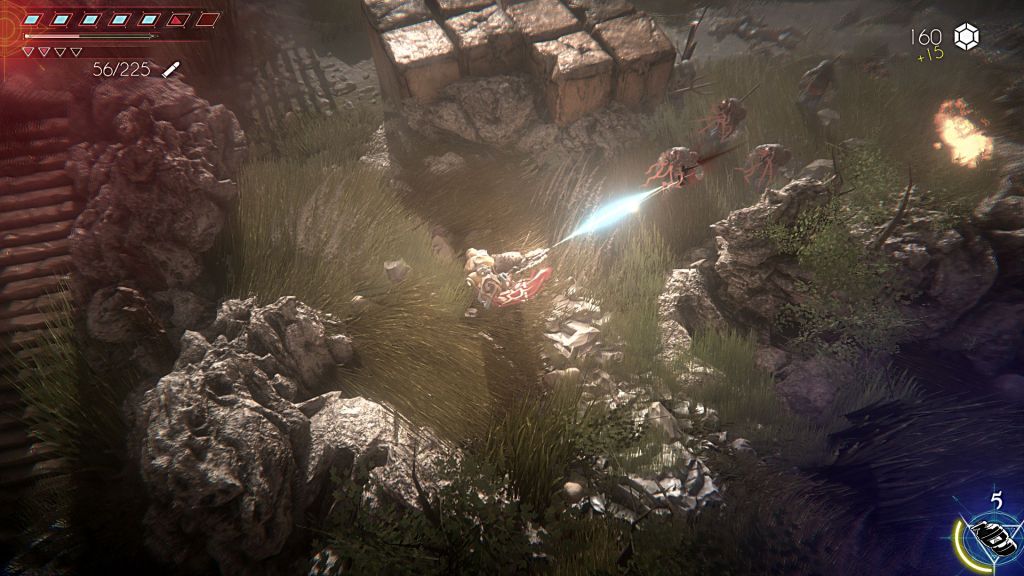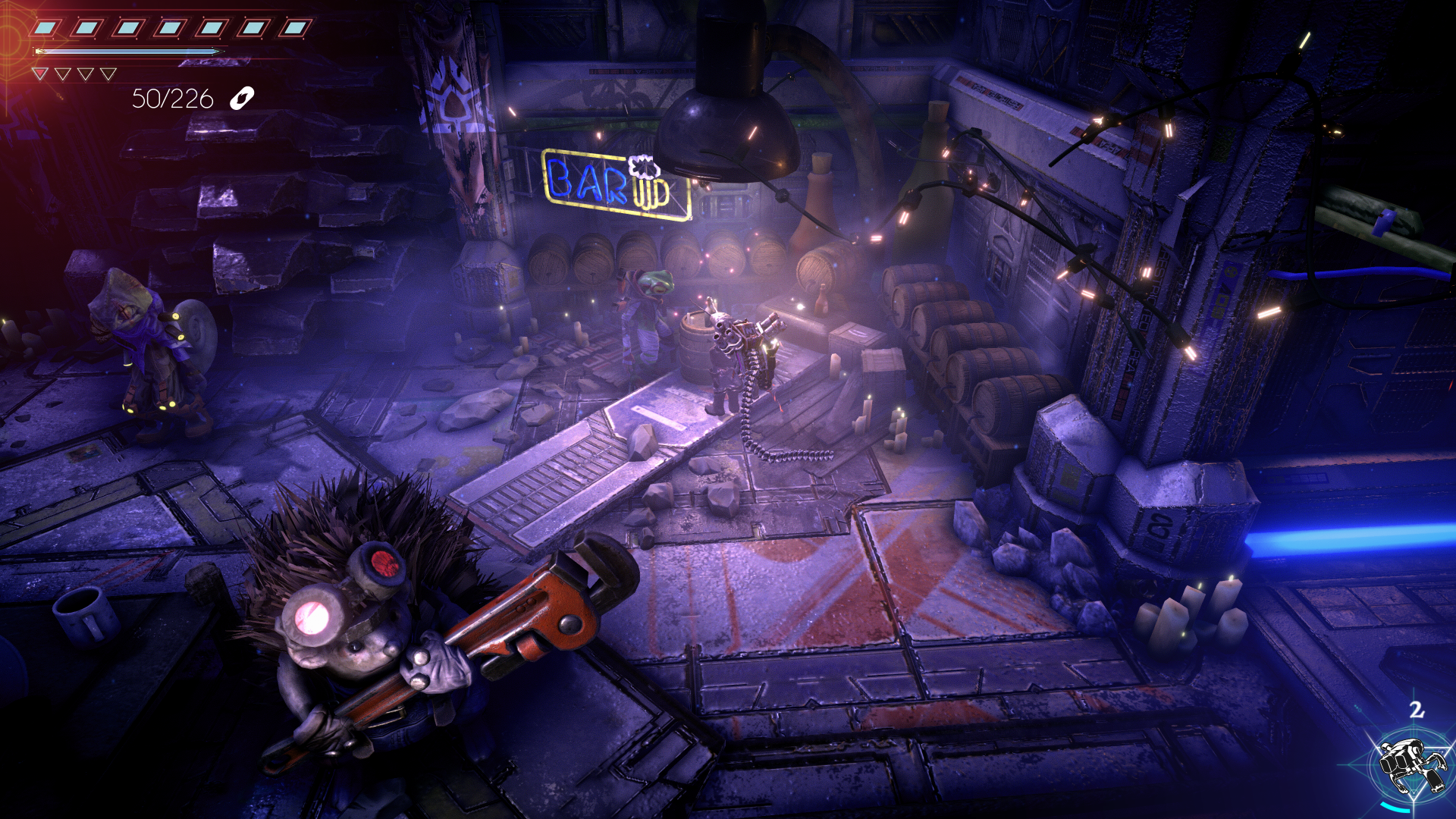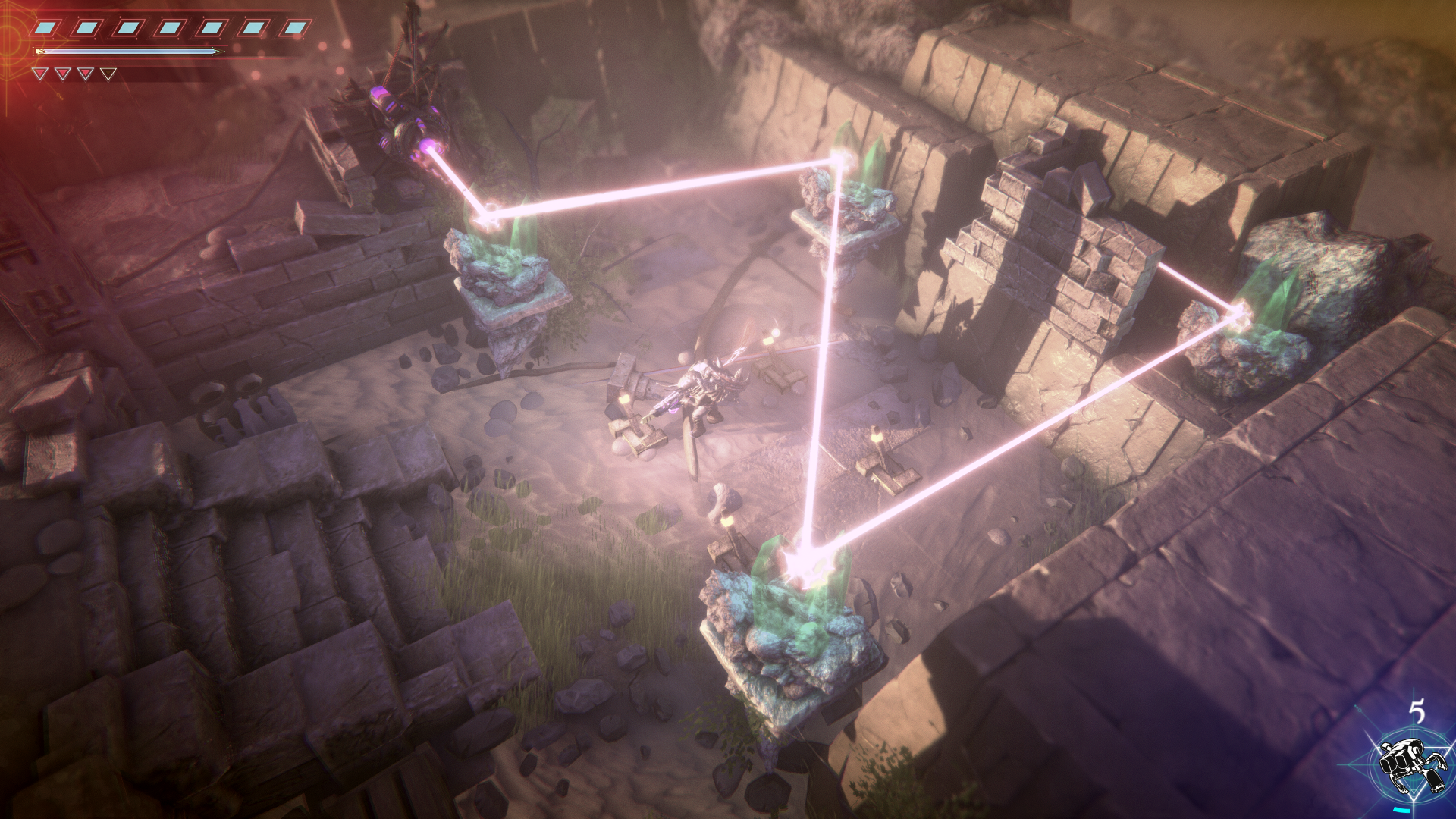Clid the Snail is a weird one, and I applaud Weird Beluga for going all in on this bizarre concept of a grumpy anthropomorphic snail with a gun going through a grim, dark post-apocalyptic world ravaged by the slug plague. Clid is an outcast from the Snail Citadel who ends up begrudgingly teaming up with other animal outcasts in a group called Alastor. Their goal is to gain favor and reputation by helping the other animal citadels eliminate the slug plague, but it soon becomes apparent that there’s perhaps a little more going on here than first glance may have indicated.
Inspired by twin-stick shooters, Clid the Snail pulls back from the arcadey nature of most twin-stick games. It’s much slower-paced, more methodical. You aren’t spraying bullets everywhere, and enemies aren’t filling screen with projectiles either. Generally you’ll be fighting either waves of enemies in one area, or coming upon enemies as you explore, with some variations depending on what region you are in. As you progress, Clid will gain access to even more weaponry and ways to take down enemies. From his default energy blaster, to a flamethrower, and even a disc-launcher or acid-grenade thrower. You’ll also get grenades, mines, and at one point, a mini walking turret to help you fire some shots at slugs and other baddies.
The biggest issue with combat is that it rarely feels methodical, but more just slow for the sake of being slow. A couple of enemies have special mechanics—shields you have to break through first, or later on, metal shields that require you to use electricity to stun them, etc.—but for the most part, there isn’t a lot of obvious variety. It’s a whole lot of just kiting enemies around, and that “methodical” nature just makes the combat feel slow and overwhelming if you end up facing down too many enemies at once. A few of the wave-based encounters ended in frustrating losses, and a strict checkpoint system that relies almost solely on activating specific dandelion checkpoint markers means death can result in a lot of lost progress.
Clid the Snail Review – Clid’s World
The level design is fascinatingly detailed, and it’s always fun to come across familiar objects that make up Clid’s tiny world. Whether it’s the CD jewel case (with the Summer Mix 2020 inside!) used as a table in the Alastor base or walking across a human spine as a bridge, the world design is consistently clever and interesting. However, the art style runs into a few problems with its generally drab, desaturated look. Most of the world appears to be covered in various levels of haze. The low color saturation and low-contrast visual style used to make the world look grim and barren also tends to make navigation and combat difficult. Often times the environment can seem to blend together, and visibility on enemies isn’t always obvious. It’s a shame, given the excellent design of the world and characters. A little more contrast to help characters, enemies, and important objects stand out would help a lot.
One slug lair in particular presented a lot of visibility issues. Not only did enemies blend into an overwhelmingly drab brown/red environment, but a large chunk of the environment blocked the camera in one corner of the arena. I took a lot of unfair hits in this encounter, died numerous times, and had to replay the whole thing far too often for my liking. Many of the enemies rely on melee attacks, rushing Clid while he frantically attempts to reload weapons or misses point-blank shots because there’s virtually no aim-assist to help hit a rapidly charging slug (yes, I realize how ridiculous those three words sound together).
I really appreciate what Weird Beluga was going for with trying to take the twin-stick shooter formula and slow it down a bit, but between the drab art style and the sluggish gameplay (no, I will not apologize for that pun), Clid can quickly become overwhelmed. Similarly, just navigating the environment is too often a chore without any kind of minimap to help you scour every corner for hidden secrets and collectibles that can increase your health or get you new shells. Despite having legs, Clid moves at a snail’s pace. The dash button will let you get a very small burst of speed for about three or four seconds, until your stamina meter runs out. This means that running back and forth across the vast, meandering, and serpentine levels to find any items, chests, or secret areas you may have missed is a test of patience. Oh, and then the area where they decided to put mud that slows Clid down even more? A literal slog.
Part of this comes from the mish-mashed pacing across the game. There are some sections and levels that seem to drag on forever for no reason, and yet others like the Fish Citadel, are exquisitely paced in a way that makes it a lot of fun to go through (even if the Fish Citadel “boss” is yet another wave-based “destroy the lair” encounter). Puzzles dot the experience between enemy encounters, occasionally having some clever solutions, but mostly just being a combination of “pull the right levers and guide this laser to the right place.” A couple did present some obtuse mechanics that weren’t immediately obvious, like heating up a crystal to make the way the laser bounces through it rotate.
Clid the Snail Review – Mysteries Abound
Despite these issues, however, Clid the Snail has an interesting story to be told. This post-apocalyptic animal-ruled world had me gripped. Characters and interactions can sometimes be a bit simple and one-dimensional, but I still went to every corner of the Alastor base after missions to talk to every member of the group of outcasts to learn their stories and expand on the mystery. What’s going on up at the snail citadel? What aren’t you telling us Cassius? What made the game’s first boss, Ska, abandon Alastor to burn down the entire grasshopper citadel? There’s a lot of engaging mystery to be had when Clid isn’t literally stuck in the mud.
Clid the Snail’s biggest obstacle is the multiple quality of life issues that make the player experience less-than-ideal at times. For example, the interact prompt to speak with characters or interact with an object pops up down in the bottom left corner of the screen. This means that as you are walking around, you have to keep glancing for the small, almost unnoticeable notification that says “press X to speak” in the corner, when it should realistically be a pop-up over the characters’ heads. Slow walking speeds with an unnecessary stamina bar. Poor visibility in the level design. Lack of aim assist making for missed shots that skirt just to the sides of enemies. The strict checkpoint system. No single one of them is entirely game breaking, but they all add up to really drag down the experience.
Clid the Snail is a lot of really interesting ideas executed in a way that feels really rough around the edges. It’s almost there in many ways, but some quality of life issues and design choices hold back the unique concept. Its brilliant art and character design is masked by some hazy aesthetic choices. Its “methodical” combat often ends up more cumbersome and overwhelming than tactical. An interesting story, world, and mystery, however, helped to keep my interest despite these issues. If you love taking a chance on weird ideas—and that key art of Clid with his gun caught your attention—it’s worth experiencing Clid’s world, but be prepared for a number of speedbumps along the way.
Clid the Snail review code provided by publisher. Reviewed on PS5. For more information, please read our Review Policy.
-
Fascinatingly weird concept
-
Engaging mystery at the center of the story
-
Those satisfying slug explosions
-
Drab and hazy art style makes visibility difficult
-
Enemies can be really hard to see in the world
-
Clid has humanoid legs, yet still moves at a snail's pace
-
Multiple quality-of-life issues that make the experience feel rough












